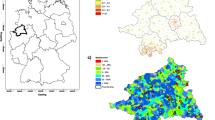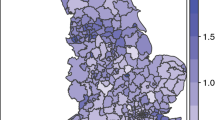Abstract
The spatial filter method, which belongs to the class of kernel density estimation methods, has been used to make morbidity and mortality maps in several recent studies. We propose improvements in the method to include spatially adaptive filters to achieve constant standard error of the relative risk estimates; a staircase weight method for weighting observations to reduce estimation bias; and a parameter selection tool to enhance disease cluster detection performance, measured by sensitivity, specificity, and false discovery rate. We test the performance of the method using Monte Carlo simulations of hypothetical disease clusters over a test area of four counties in Iowa. The simulations include different types of spatial disease patterns and high-resolution population distribution data. Results confirm that the new features of the spatial filter method do substantially improve its performance in realistic situations comparable to those where the method is likely to be used.













Similar content being viewed by others
References
Anselin L (1995) Local indicators of spatial association–LISA. Geogr Anal 27(2):93–115
Assunçao R, Costa M, Tavares A, Ferreira S (2006) Fast detection of arbitrarily shaped disease clusters. Stat Med 25(5):723–742
Bell BS, Hoskins RE, Pickle LW, Wartenberg D (2006) Current practices in spatial analysis of cancer data: mapping health statistics to inform policymakers and the public. Int J Health Geogr 5:49
Benjamini Y, Hochberg Y (1995) Controlling the false discovery rate: a practical and powerful approach to multiple testing. J Roy Stat Soc B 57(1):289–300
Bhaduri B, Bright E, Coleman P, Dobson J (2002) LandScan: locating people is what matters. Geoinformatics 5(2):34–37
Bhaduri B, Bright E, Coleman P, Urban M (2007) LandScan USA: a high-resolution geospatial and temporal modeling approach for population distribution and dynamics. GeoJournal 69(1):103–117
Bithell JF (1990) An application of density estimation to geographical epidemiology. Stat Med 9(6):691–701
Boulos MN (2005) Web GIS in practice III: creating a simple interactive map of England’s strategic health authorities using google maps api, google earth kml, and msn virtual earth map control. Int J Health Geogr 4:22
Cai Q, Rushton G, Bhaduri B, Bright E, Coleman P (2006) A methodology for estimating small-area population by age and sex based on methods of spatial interpolation and statistical Inference. Trans GIS 10(4):577–598
Castro MC, Singer B (2006) Controlling the false discovery rate: a new application to account for multiple and dependent tests in local statistics of spatial association. Geogr Anal 38(2):180–208
Cliff A, Haggett P (1988) Atlas of disease distributions: analytic approaches to epidemiological data. Oxford, Blackwell
Davies TM, Hazelton ML (2010) Adaptive kernel estimation of spatial relative risk. Stat Med 29(23):2423–2437
French JL, Wand MP (2004) Generalized additive models for cancer mapping with incomplete covariates. Biostatistics 5(2):177–191
Gelman A, Price PN (1999) All maps of parameter estimates are misleading. Stat Med 18(23):3221–3234
Gelman A, Price PN, Lin CY (2000) A method for quantifying artifacts in mapping methods illustrated by application to headbanging. Stat Med 19(17):2309–2320
Getis A, Ord KJ (1996) Local spatial statistics: an overview. In: Longley P, Batty M (eds) Spatial analysis: modelling in a GIS environment. Wiley, New York, pp 261–277
Getis A, Ord KJ (2000) Seemingly independent tests: addressing the problem of multiple simultaneous and dependent tests. 39th Annual Meeting of the Western Regional Science Association, Kauai, Hawaii
Goovaerts P, Jacquez GM (2004) Accounting for regional background and population size in the detection of spatial clusters and outliers using geostatistical filtering and spatial neutral models: the case of lung cancer in Long Island, New York. Int J Health Geogr 3:14
Goovaerts P, Jacquez GM (2005) Detection of temporal changes in the spatial distribution of cancer rates using local Moran’s I and geostatistically simulated spatial neutral models. J Geograph Syst 7(1):137–159
Hansen KM (1991) Headbanging: robust smoothing in the plane. IEEE Trans Geosci Remote Sens 29(3):369–378
Kafadar K (1997) Geographic trends in prostate cancer mortality: an application of spatial smoothers and the need for adjustment. Ann Epidemiol 7(1):35–45
Kulldorff M (1997) A spatial scan statistic. Commun Stat Theor M 26(6):1481–1496
Lawson AB (2001) An introductory guide to disease mapping. Wiley, New York
Lawson AB, Biggeri AB, Boehning D, Lesaffre E, Viel JF, Clark A, Schlattmann P, Divino F (2000) Disease mapping models: an empirical evaluation disease mapping collaborative group. Stat Med 19(17):2217–2241
Mollié A (1996) Bayesian mapping of disease. In: Gilks WR, Richardson S, Spiegelhalter DJ (eds) Markov chain monte carlo in practice. Chapman & Hall, New York, pp 360–379
Oden N (1995) Adjusting Moran’s I for population density. Stat Med 14(1):17–26
Openshaw S (1984) The modifiable areal unit problem. Geobooks, Norwich
Openshaw S, Charlton ME, Wymer C, Craft A (1987) A mark I geographical analysis machine for the automated analysis of point data sets. Int J Geogr Info Sys 1(4):335–358
Ozdenerol E, Williams BL, Kang SY, Magsumbol MS (2005) Comparison of spatial scan statistic and spatial filter in estimating low birth weight clusters. Int J Health Geogr 4:19
Richardson S, Thomson A, Best N, Elliott P (2004) Interpreting posterior relative risk estimates in disease-mapping studies. Environ Health Perspect 112(9):1016–1025
Rushton G (2003) Public health, GIS, and spatial analytic tools. Annu Rev Public Health 24(1):43–56
Rushton G, Lolonis P (1996) Exploratory spatial analysis of birth defect rates in an urban population. Stat Med 15(7):717–726
Shi X (2009) A geocomputational process for characterizing the spatial pattern of lung cancer incidence in New Hampshire. Ann Assoc Am Geogr 99(3):521–533
Shi X, Duell E, Demidenko E, Onega T, Wilson B, Hoftiezer D (2007) A polygon-based locally-weighted-average method for smoothing disease rates of small units. Epidemiology 18(5):523–528
Silverman BW (1986) Density estimation for statistics and data analysis. Chapman & Hall, London
Talbot TO, Kulldorff M, Forand SP, Haley VB (2000) Evaluation of spatial filters to create smoothed maps of health data. Stat Med 19(17):2399–2408
Tiwari C, Rushton G (2004) Using spatial adaptive filters to map late-stage colorectal cancer incidence in Iowa. In: Fisher P (ed) Advances in spatial data handling II. Springer, Berlin, Heidelberg, New York, pp 125–136
Tobler W (1970) A computer movie simulating urban growth in the detroit region. Econ Geogr 46(Suppl):234–240
Turnbull BW, Iwano EJ, Burnett WS, Howe HL, Clark LC (1990) Monitoring for clusters of disease: application to leukemia incidence in upstate New York. Am J Epidemiol 132(1 Suppl):S136–S143
Waller L, Gotway CA (2004) Applied spatial statistics for public health data. Wiley, New York
Waller L, Jacquez GM (1995) Disease models implicit in statistical tests of disease clustering. Epidemiology 6(6):584–590
Acknowledgments
We sincerely thank the editor and the two anonymous reviewers for their many constructive comments and suggestions. Rushton and Cai acknowledge support from the National Cancer Institute Grant #N01-PC-31543.
Author information
Authors and Affiliations
Corresponding authors
Rights and permissions
About this article
Cite this article
Cai, Q., Rushton, G. & Bhaduri, B. Validation tests of an improved kernel density estimation method for identifying disease clusters. J Geogr Syst 14, 243–264 (2012). https://doi.org/10.1007/s10109-010-0146-0
Received:
Accepted:
Published:
Issue Date:
DOI: https://doi.org/10.1007/s10109-010-0146-0




